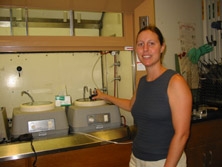
School:
Grade Level:
Teaching Position:
Supervisor:
Department:
Mentor:
Research Project Year:
Research Project Title:
Research Project Description:
Galium Nitride (GaN) thin films are used to produce Light Emitting Diodes (LEDs) and Lasers in the higher frequencies of the visible spectrum of light. LEDs are used in flashlights, VCRs, watches, street lights, and many many other applications, and are much more efficient, durable, and stable than traditional light sources. GaN is also used to make transistors, which are an integral part of the computer. Many scientists are exploring ways to make GaN thin films more pure and at a faster rate. In order to test the film quality, the Transmission Electron Microscope (TEM) is utilized to produce high resolution images on the order of nanometers. TEM samples must be prepared such that they are very thin (~10 nm). This process of TEM sample preparation could take a few hours or a few days. Manual sample preparation yeilds more control and sometimes higher sample quality, while automated sample preparation using the Focused Ion Beam (FIB) produces quick samples.
Research Project Attachments:
| Attachment | Size |
|---|---|
| 1.77 MB |
Curriculum Project Year:
Curriculum Project Title:
Curriculum Project Description:
During my first summer in the RET program I realized that the correct approach to a scientific investigation was critical to my engagement, understanding, ownership, and enthusiasm in the project. This summer, my curriculum project was based on developing a structure in which my students could conduct scientific experiments while maximizing their engagement, understanding, ownership, and enthusiasm for the activity in addition to improving their critical thinking and literacy skills.
Students will conduct labs that reflect a real-life, successful, and satisfying scientific investigation by first being given sufficient background knowledge, then being handed a set of equipment along with a scientific question. The students are required to develop a hypothesis before proceeding with the lab, and then are encouraged to tinker with the equipment. Then the students designs their own experiment as they conduct the investigation using an iterative process; students may initially decide to proceed one way and then change course when they become more familiar with the equipment or realize any limitations. The actual writing of the procedure section is one of the last steps in the lab process (similar to the writing of the methods section for a thesis or dissertation being done at the end of the graduate program).
To demonstrate their learning and adequate participation in the lab, students are given a one to two paragraph writing assignment when they finish each lab. Students rotate through writing each section of a scientific report, including the introduction, methods, results, conclusion, and abstract sections. One section is assigned for each lab. Students rewrite essays incorporating teacher and peer-feedback, and log their essay improvements in an organized lab notebook. This process of inviting more critical thinking skills in the scientific investigation process has resulted in more focused group work, increased student engagement, improved organizational and writing skills, an enhanced impact of labs on student learning, and an increased enthusiasm for labs and science in general.
Curriculum Project Attachments:
| Attachment | Size |
|---|---|
| 1003 KB |
